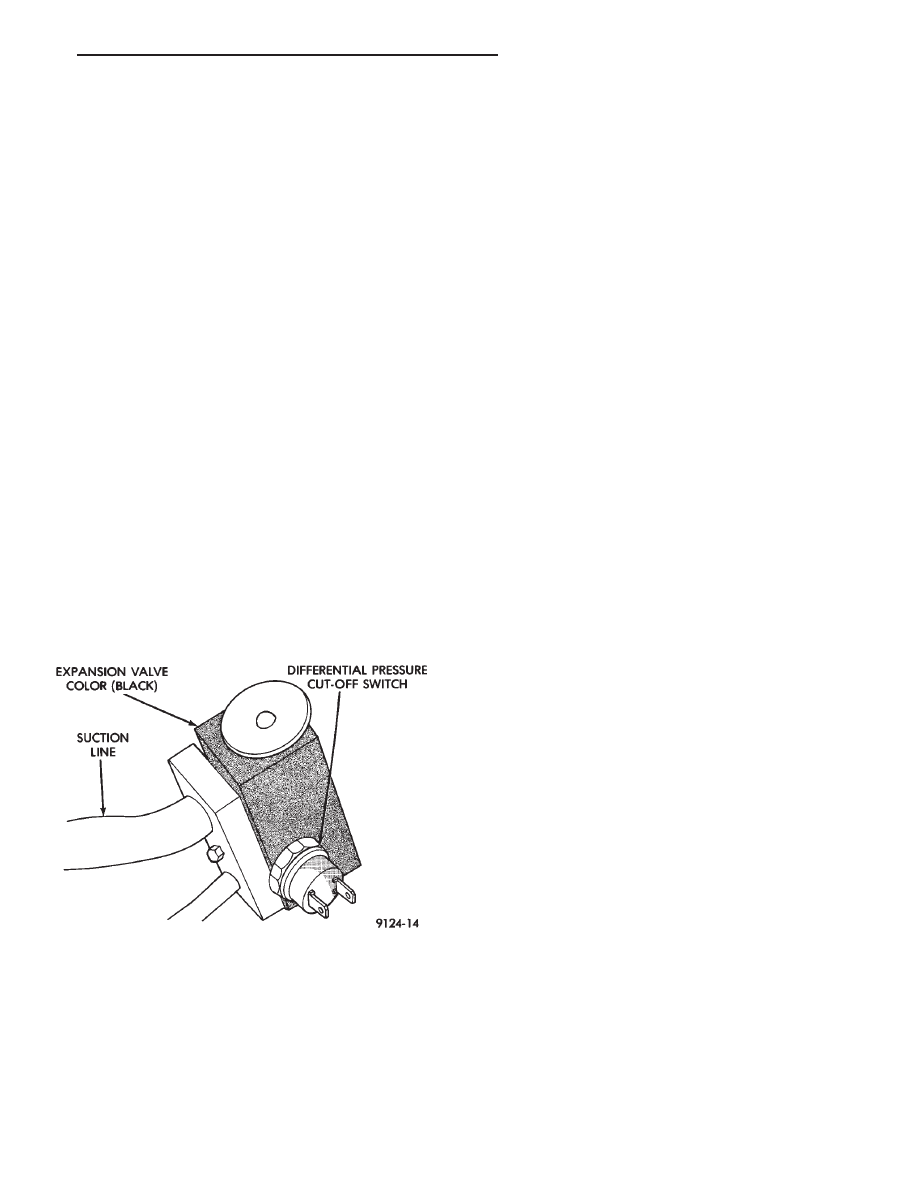Chrysler Town & Country/Voyager, Dodge Caravan, Plymouth Voyager. Manual - part 129

(4) If the high pressure gauge reads below 2963 kPa
(430 psi)
6138 kPa (20 psi) the compressor clutch
should be engaged.
CAUTION: Do not allow engine to overheat when
radiator air flow is blocked.
(5) Block radiator air flow with a suitable cover to
increase the high side pressure to at least 3100 kPa
(450 psi). Compressor clutch should disengage.
(6) Remove cover from front of vehicle to allow high
side pressure to decrease. When pressure drops below
1826 kPa (265 psi), compressor clutch should engage.
If High Pressure Cut-Out Switch is defective, replace
it.
BLACK EXPANSION VALVE TEST
Review Safety Precautions and Warnings in the
General Information section of this Group. The work
area temperature must be 21°C to 27°C (70°F to 85°F)
when testing expansion valve. To test the expansion
valve:
(1) Connect a charging station or manifold gauge set
to the refrigerant system service ports. Verify the
refrigerant charge level using the sight glass method.
(2) Disconnect and plug the vacuum line at the
water control valve.
(3) Disconnect the wire connector at the differential
pressure cut-off switch. Using a jumper wire, jump
across the terminals inside the connector boot (Fig. 5).
(4) Close all doors, windows and vents to the passen-
ger compartment.
(5) Set heater-A/C control to A/C, full heat, FLOOR,
and high blower. System should be in a recirculation
mode with reheat. This is not possible with control.
(6) Remove lower right side of panel and switch the
two vacuum lines to allow reheat with recirculation.
(7) Start the engine and allow to idle (1000 R.P.M.).
After the engine has reached running temperature,
allow the passenger compartment to heat up to create
the need for maximum refrigerant flow into the evapo-
rator.
(8) Discharge (high pressure) gauge should read 965
to 1655 kPa (140 to 240 psi) when the refrigerant
charge is sufficient. If system cannot achieve proper
pressure, replace the expansion valve. If pressure is
correct, record reading and proceed with test.
WARNING: PROTECT SKIN AND EYES FROM CON-
TACTING CO
2
PERSONAL INJURY CAN RESULT.
(9) If discharge pressure is within specified range,
freeze the expansion valve control head for 30 seconds.
Use a super cold substance (liquid CO
2
).Do not spray
R-12 Refrigerant on the expansion valve for this
test. If compressor discharge (high) pressure does not
drop by 15% or more of the pressure recorded in step 8,
replace the expansion valve. Allow the expansion valve
to thaw. The discharge pressure should stabilize to the
pressure recorded in step 8. If the pressure does not
stabilize, replace the expansion valve.
(10) Correct water valve vacuum line and recirc.
actuator lines. Install lower right panel.
HIGH PRESSURE RELIEF VALVE (HPR) DIAGNOSIS
The HPR valve prevents damage to the air-
conditioning system if excessive pressure develops.
Excessive pressure can caused by condenser air flow
blockage, refrigerant overcharge, or air and moisture
in the system.
HPR VALVE LOCATION
The HPR Valve is located on the compressor end
plate. (Fig. 6).
The high pressure relief valve vents only a small
amount of refrigerant necessary to reduce system pres-
sure and then reseats itself. The majority of the refrig-
erant is conserved in the system. The valve is cali-
brated to vent at a pressure of 3100 to 4140 Kpa (450 to
600 psi). If a valve has vented a small amount of
refrigerant, it does not necessarily mean the valve is
defective.
For (HPR) valve replacement, refer to Variable Dis-
placement Compressor Service Procedures.
Fig. 5 Differential Pressure Cut-Out Switch
.
HEATING AND AIR CONDITIONING
24 - 11